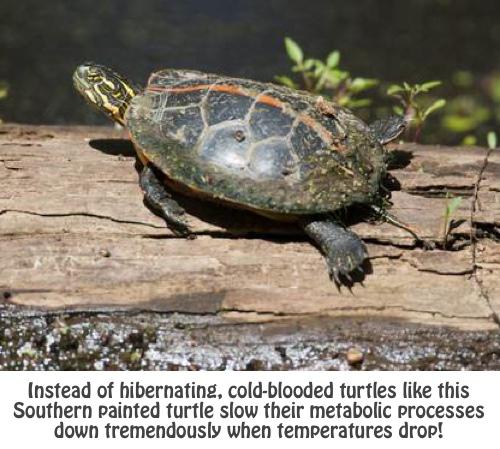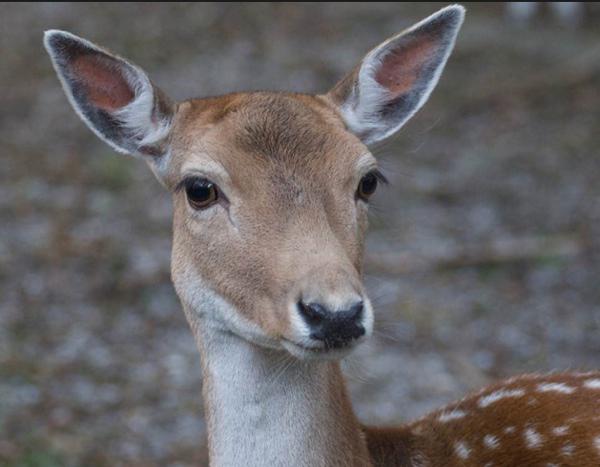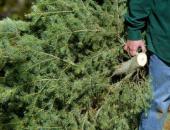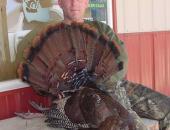Local News
Turtle Power!
January 07th 2015 by Dee Loflin

Instead of hibernating, cold-blooded turtles slow their metabolic processes down tremendously when temperatures drop, he said.
“They’re in a dormant, inactive state,” he said.
When temps drop they seek out environments that will provide the most stable temperature to wait out the winter months. Turtles have to save energy in order to survive the winter, so if they have to endure fast temperature changes, it costs them some of their fat stores, which puts them in danger.
“For example, a common snapper may descend to a deep submerged log pile in a pond or creek and curl up and wait out the winter with little movement, if any,” Henry said, adding that even the turtle’s respiration and heart beat rates will decrease dramatically to help save energy.
“Instead of breathing, aquatic turtles can absorb oxygen from the water through their skin,” he said.
Box turtles dig burrows and red eared sliders burrow into mud at the bottom of wetlands for protection from extreme winter temperatures. They won’t eat as much food throughout the winter either since eating will increase their metabolic rate.
“Slow and steady is the name of the game for a turtle to survive the winter,” Henry said.
Henry said people can help turtles by providing good places for them to hide. They need soil to burrow in the forests, plants to take shelter in in the wetlands, and overall healthy habitat and waters where they can seek refuge from the cold.
“Like us, turtles need a place to take shelter from the cold,” he said. “That shelter can be a rotted-out log on the south slope of an Ozark woods or a downed cypress treetop in a bootheel slough.”
“Turtles and other wildlife are tremendously stressed when temperatures decline to the levels we experience in Missouri,” he said. “The main thing people can do during the winter months make sure they don’t disturb habitat unnecessarily when weather conditions are bad.”
For example, a pond drained in the winter may freeze many of the aquatic species that may have been able to move to nearby wetlands had the temperatures been higher.
“Wildlife can’t survive the disturbances or destruction of habitat while they struggle against adverse weather conditions,” he said.
To find more information on winter wildlife and what you can do to help them, go online to mdc.mo.gov.
Last Updated on January 07th 2015 by Dee Loflin
https://showmetimes.com/Blogpost/utc7/Turtle-Power
Hunters Harvest 11,025 Deer During Alternative Methods
January 06th 2015 by Dee Loflin

For 2014 harvest totals by county and season portion, and for past season totals, visit the MDC website at http://mdc.mo.gov/node/29442.
This season’s deer hunting continues with archery hunting through Jan. 15 and the firearms late youth weekend Jan. 3-4.
The alternative methods portion replaced the muzzleloader portion of firearms deer season in 2012. Hunters are allowed to use muzzle-loading firearms, center-fire pistols, air-powered guns, bows, crossbows, or atlatls during the alternative-methods hunt.
Conservation makes Missouri a great place to hunt deer for about 520,000 hunters. Deer hunting is also an important economic driver in Missouri. It supports more than 12,000 jobs and gives a $1 billion annual boost to state and local economies. Many businesses rely on deer hunting as a significant source of revenue, such as meat processors, taxidermists, hotels, restaurants, sporting goods stores, and others.
For more on Missouri deer hunting, go online to www.mdc.mo.gov.
Last Updated on January 06th 2015 by Dee Loflin
https://showmetimes.com/Blogpost/utbd/Hunters-Harvest-11025-Deer-During-Alternative-Methods
A Year In Review with Missouri Conservation July - Dec 2014
January 02nd 2015 by Dee Loflin

Nature lovers found much to celebrate in 2014 and continued to expand the frontiers of conservation in the Show-Me State. Here is a brief summary of the first last month's of 2014's outdoor news stories.
JULY
Missouri Gov. Jay Nixon nominated former Conservation Federation of Missouri Executive Director Dave Murphy to a six-year term on the Conservation Commission.
A citizen alerted state conservation and agriculture officials to an emerald ash borer infestation in St. Charles County. It was the destructive insect’s first known infestation in the St. Louis area.
AUGUST
Thousands of people visited the Conservation Pavilion at the Missouri State Fair in Sedalia, peering into aquariums teeming with live fish and terrariums harboring exciting reptiles and amphibians. Staff from every conservation discipline were on hand to answer questions and present live programs on topics ranging from birds of prey to fish cleaning and cooking demonstrations.
MDC waterfowl biologists announced that duck-hunting prospects were extremely bright, with mallard numbers topping 10 million and blue-winged teal numbers at a record 8.5 million.
A Colorado man pleaded guilty to illegally trafficking paddlefish caviar obtained in Warsaw in 2012. The case was part of an undercover investigation called "Operation Roadhouse” led by U.S. Fish and Wildlife Service and MDC. To date, 240 out of 256 state charges have been completed against numerous individuals with over $61,000 in fines and court costs levied. The fine money went to the school districts in the counties where the violations were committed.
MDC released alligator gar reared at its Chesapeake Hatchery in Mount Vernon in a continuing effort to restore the species at Mingo National Wildlife Refuge and other parts of southeast Missouri. The alligator gar is by far the largest of gars and is one of the largest freshwater fishes in North America, sometimes reaching 10 feet in length and 350 pounds. The species was driven to near extinction partly because they were mistakenly believed to reduce numbers of sport fish.
SEPTEMBER
Missouri’s Sept. 1 opening of dove season fell on the Labor Day weekend, drawing larger than usual crowds of hunters at more than 100 conservation areas with fields specially managed for dove habitat.
Conservation agents helped rescue eight motorists stranded on or near Interstate 29 by a flash flood in Holt County and a school bus driver stranded on Route N north of Mound City.
MDC released a small-game hunting forecast showing quail, pheasant, and squirrel numbers increasing and rabbits likely to follow the trend. Results of the annual wild-turkey brood survey showed a poult-to-hen ratio 26 percent greater than the previous 10-year average.
MDC offered a new application for mobile devices that lets hunters and anglers buy permits and view permits purchased during the previous year. The MO Hunting app also allows deer and turkey hunters to telecheck their current harvests and view past telechecked harvests. Learn more at mdc.mo.gov/mobile/mobile-apps/mo-hunting.
About 30 MDC staff specially trained in fighting wildfires helped their western colleagues contain and extinguish wildfires in northern California, Oregon, Idaho, and Montana.
This year, Missouri hatcheries stocked more than 1.5 million trout in trout parks, Ozark streams, and winter fishing lakes. MDC warm-water hatcheries stocked more than 10 million fish in public waters including hybrid striped bass, walleye, muskie, channel catfish, paddlefish, hybrid sunfish, and hybrid striped bass.
OCTOBER
Self-guided driving tours to view wild elk at Peck Ranch and Current River Conservation Areas continued to grow as a tourist draw for the Ozarks, especially in the fall when bull elk bugle as part of their mating ritual. MDC estimates the Missouri elk herd has grown to more than 120 animals.
MDC’s Champion Tree Program certified several new state-record trees including a 95-foot tall black willow in St. Louis County, a 118-foot swamp chestnut oak near East Prairie, and an 82-foot-tall slippery elm in Neosho.
The Springfield Conservation Nature Center celebrated 25 years of serving millions of Missourians with special events and programs.
MDC and Ducks Unlimited hosted a dedication ceremony to celebrate the completion of a multi-year renovation project at Duck Creek Conservation Area in Bollinger, Stoddard, and Wayne counties. The project was part of the Golden Anniversary Wetlands Initiative launched in 2004 to revitalize managed wetland projects constructed in the mid-20th century.
MDC, Ducks Unlimited, Conservation Federation of Missouri, Missouri Conservation Heritage Foundation, Bass Pro Shops, and dozens of other conservation and hunting organizations partnered on the 480-page book, Waterfowl Hunting and Wetland Conservation in Missouri - A Model of Collaboration. For ordering information, visit mochf.org/2014/04/book-waterfowl-hunting-and-wetlands-conservation-in-missouri/.
The Conservation Commission approved regulations regarding the operation of hunting preserves and wildlife breeding facilities that hold captive deer. The regulations focused on preventing the spread of diseases, including chronic wasting disease. MDC received more than 40,000 public comments on the topic with most supportive of the regulation changes. The spread of chronic wasting disease could negatively impact Missouri deer hunting as well as deer-dependent businesses that support more than 12,000 Missouri jobs and generate over $1 billion in economic activity annually.
Hunters checked 5,691 turkeys during Missouri’s fall firearms turkey season Oct. 1-31.
Working with conservation partners and private landowners MDC reintroduced Topeka shiners to the Spring Creek watershed in northeast Missouri. This small prairie minnow was once common in Missouri and is designated as a federally endangered species. The minnows were released on Union Ridge Conservation Area and designated as a “non-essential experimental” population, which allows landowners and managers to continue with normal agricultural and land management practices.
NOVEMBER
Building on a strong opening weekend harvest, Missouri hunters checked 167,205 deer during firearms deer season Nov. 15-25. The number exceeds last year’s harvest of 157,273. Top harvest counties were Howell with 3,418 deer checked, Franklin with 3,338, and Texas with 3,170.
The Department gathered public comments for dozens of conservation areas, river accesses and nature centers throughout the year. In November, this included an open house at James A. Reed Memorial Wildlife Area. Hundreds of comments received are being used to help develop management plans at these popular destinations. To comment on area management plans, visit mdc.mo.gov/areaplans.
DECEMBER
The Department started a five year study in northwest and southcentral Missouri on white-tailed deer to determine the impact of large-scale habitat changes, hunting pressure, movement patterns, and survival rates. MDC staff are working with landowners to capture and fit deer with radio collars. Information from the study will help staff better manage our state’s valuable deer herd.
Hunters checked 9,107 deer during the antlerless portion of Missouri’s firearms deer season, bringing this year’s tally to more than 240,000. Remaining portions include alternative-methods portion Dec. 20-30 and the late youth portion Jan. 3-4.
Last Updated on January 02nd 2015 by Dee Loflin
https://showmetimes.com/Blogpost/utb0/A-Year-In-Review-with-Missouri-Conservation-July--Dec-2014
A Year In Review with Missouri Conservation Jan - June 2014
January 02nd 2015 by Dee Loflin

Nature lovers found much to celebrate in 2014 and continued to expand the frontiers of conservation in the Show-Me State. Here is a brief summary of the first six month's of 2014's outdoor news stories.
JANUARY
The second-largest archery deer harvest in Missouri history (50,507) pushed the final tally for the 2013-2014 hunting season to 252,574.
Hunters donated 227,358 pounds of venison to needy Missourians during the 2013-2014 hunting season. That is enough for more than 600,000 meals. Get more information on Share the Harvest at mdc.mo.gov/node/2544.
MDC researchers started a five-year study in northeast Missouri to better manage our valuable wild turkey population. Staff captured 260 turkeys in Putnam, Schuyler, Monroe, and Marion counties to radio track the birds throughout the year to determine survival rates and nesting success.
FEBRUARY
The National Wild Turkey Federation named Conservation Agent Jeff Berti its 2013 National Law Enforcement Officer of the Year. Berti, who has served 19 years in Grundy County, also won the NWTF's Missouri State Law Enforcement Officer of the Year Award. In 2013, he documented 248 resource violations, made more than 112 arrests, and 31 assisted arrests. His efforts resulted in the detection of 42 violations and 30 arrests for illegally killing wild turkeys in a single five-month period.
Working with the U.S. Department of Agriculture, conservation groups, agriculture organizations and landowners, the Department continued to lead the battle against feral hogs. Last year more than 1,400 feral hogs were removed from Missouri’s landscape.
MARCH
The four trout parks were stocked with more than 30,000 keeper-size trout for opening day. A late snow storm kept some anglers away, but those that came enjoyed an excellent opening weekend.
Paddlefish snaggers found a bumper crop of big “spoonbills” in the Osage River, Lake of the Ozarks, Truman Lake, and Lake Taneycomo thanks to a record stocking of more than a quarter of a million paddlefish from MDC’s Blind Pony Hatchery in 2008 and an additional 145,000 stocked in 2007. These two strong year classes will continue to provide superb fishing over the next few years.
Missouri hosted the first-ever white-tailed deer summit meeting March 3-6 at Big Cedar Lodge near Branson. The meeting brought more than 200 hunters, landowners, wildlife managers, and hunting-industry representatives from the U.S. and Canada. Deer hunters from 20 states, representatives of state and provincial wildlife agencies, citizen conservation groups, universities, and deer-research institutes heard reports from some of North America’s top deer experts. Afterwards, MDC staff facilitated the process of identifying the most pressing issues facing those who love white-tailed deer.
MDC received calls from all over the state about fish kills in large and small lakes and ponds. After looking into the reports, biologists concluded that the widespread problem was the result of an unusually cold winter.
Missouri Stream Team celebrated 25 years of a citizen movement that now has more than 85,000 volunteers working to protect and improve Missouri streams. Sponsored by MDC, the Missouri Department of Natural Resources, and the Conservation Federation of Missouri, the program focuses on education, stewardship, and advocacy for Missouri stream resources.
The sixth annual Missouri National Archery in the Schools Program tournament at Tan-Tar-A Resort March 28-29 turned into a record-fest in which the state record score fell and fell again, and again. The tournament brought together nearly 1,267 contestants in grades 4-12 from 81 schools to test their skills with bow and arrow. Eighth-grader Joe Wilder of St. Peters set a new tournament record by scoring 295 points out of 300 possible. The next day Hunter Berry, a 12th-grader from Sarcoxie, nudged it up another notch to 296. Lee’s Summit High School Freshman Shelby Winslow had the last word when she raised the bar to 297 points, just two points shy of the world record.
APRIL
Young hunters checked 4,332 turkeys during Missouri’s youth turkey hunting season, topping the 4,000 mark for the second time in the youth season’s 14-year history.
The Conservation Commission voted to reduce the number of firearms antlerless deer permits that a hunter may fill in all or part of 59 counties. It also reduced the availability of antlerless permits to two in all or part of another 19 counties. In previous years, hunters could buy any number of antlerless permits in most of the affected counties. Although the regulation changes reduce the number of antlerless tags that can be filled in many counties, hunters still can fill multiple firearms antlerless tags as long as they do not fill more than is allowed in a particular county. The change addressed hunter and landowner concerns about recent declines in deer numbers in some counties.
Working with the Iowa Department of Natural Resources and The Nature Conservancy, greater prairie chickens were trapped in Nebraska and released at The Nature Conservancy’s Dunn Ranch and Department’s Pawnee Prairie in Harrison County. Biologists reported good numbers of booming prairie chickens at the Wah Kon Tah Prairie release site in St. Clair and Cedar counties. In recent years, the Department worked with private landowners and The Nature Conservancy to restock prairie chickens to this open grassland landscape in west-central Missouri.
Eighty-six Missouri communities achieved recognition through the Arbor Day Foundation TREE CITY USA program. These communities meet national standards showing they care for their city trees and help their residents take care of their own trees.
MAY
Missouri turkey hunters enjoyed another successful season and checked 43,273 turkeys during the regular spring turkey season, the third annual increase in a row.
The Conservation Department continued trapping black bears for the fourth year, placing radio tracking collars on dozens of bears to learn more about their habits and population dynamics. Resource Scientist Jeff Beringer estimates the Show-Me State’s bear population at 300. Learn more about the Missouri Black Bear Project at fwrc.msstate.edu/carnivore/mo_bear/
The Missouri Black Bear Foundation was formed to sponsor educational programs, conduct public outreach, and coordinate field research in partnership with conservation agencies. Get more information at moblackbears.org.
The Columbia Bottom Conservation Area's Howard and Joyce Wood Education Center celebrated its 10th anniversary. The Department and citizens celebrated the anniversary with a series of special events and programs. The area is a popular designation for hunters, anglers and wildlife watchers in the greater St. Louis area.
JUNE
The Conservation Commission approved regulation changes regarding the regulation of hunting preserves and deer-breeding facilities in an effort to reduce the risk of fatal diseases to the state’s free-ranging deer herd and captive deer.
MDC invited hunters and other Missouri residents with an interest in white-tailed deer to express their opinions about deer management at 14 open house meetings around the state in June and July. Information from the meetings and online comments are being used to develop future deer hunting regulations and the statewide deer management plan. MDC is still seeking input at mdc.mo.gov/node/28079.
Free Fishing Days on June 7-8 encouraged Missourians to enjoy the Show-Me State’s fishing resources by allowing anyone to fish without having to buy a fishing permit, trout stamp, or daily trout park tag.
The Cape Girardeau Conservation Nature Center received a TripAdvisor award for providing excellent public service.
Last Updated on January 02nd 2015 by Dee Loflin
https://showmetimes.com/Blogpost/utav/A-Year-In-Review-with-Missouri-Conservation-Jan--June-2014
Recycle Your Live Christmas Tree
January 02nd 2015 by Dee Loflin

Christmas trees provide brush and aquatic vegetation for pond and lake fish. Kennedy likens the addition of a dead tree to fish habitat to how humans furnish our homes. It gives fish resting areas, shade and escape cover.
“Small fish need vegetation and brush to help them hide from predators,” Kennedy said. “Additionally, predator fish like crappie and bass sometimes hide behind a limb to wait for an opportunity to grab its prey.”
Large trees and multiple trees make the best fish habitat, Kennedy said. He encourages neighbors to get together and combine efforts by recycling all their trees together in one lake. To place trees in a pond or lake, they’ll need to be anchored with concrete blocks. Kennedy said to place small brush piles next to each other to create larger habitat. Water depth should also be considered. The best depth is 8 feet deep in the water, with the trees placed in a row, he said.
Other ways to recycle live Christmas trees include placing in a backyard to offer cover for wildlife, or under bird feeders to provide nesting locations in the branches. Live Christmas trees can also be shredded or chipped for mulch.
For more ideas on how to help winter wildlife by developing habitat, go online to mdc.mo.gov.
Last Updated on January 02nd 2015 by Dee Loflin
https://showmetimes.com/Blogpost/utau/Recycle-Your-Live-Christmas-Tree-









